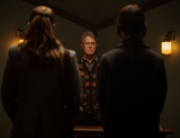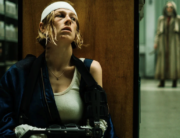This year at the Tribeca film festival, now in its 12th year, films from all over the world included some by major names (Richard Linklater’s Before Midnight and David Gordon Green’s Prince Avalanche) and newcomers trying to make their mark, not to mention the countless documentaries and short films. But not to be overlooked amid the deeper international dramas and contemplative fare were the genre films.
BIG BAD WOLVES
In this follow-up to director team Aharon Keshales and Navot Papushado’s Rabies, a child killer is on the loose, and the cops aren’t sure what direction to turn. A lead suspect, a mild-mannered schoolteacher, is roughly interrogated by a no-BS cop, who feels the intensity for this case since he has a daughter, but the suspect is freed. (The roughing up was somehow recorded.) Then another child winds up dead, beheaded after being raped, tortured, and left in the woods. After footage of the interrogation is leaked, the schoolteacher is in deeper trouble, not just from the vigilant cop hot on his trail, but by the dead girl’s father, an ex-cop.
This is a grisly effort, shot with grace, high quality camera movement, and attention to the lighting, from a brightly lit kitchen to the dark cellar where the vengeful father goes torture-porn on the school teacher’s ass. There’s humor too, mostly in the darkest touches in the dialog. This father is dead serious about getting a simple answer—where is his daughter’s head?—but he first has to check on a cake in the oven. But the movie starts to crumble apart near the end when the ambiguity is torn down and a much more clichéd ticking clock scenario settles in. Satisfying, but it could have gone even further with its outrageous dark humor.
V/H/S 2
Once again, like in the first V/H/S anthology, we’re given a series of horror films, all shot in the found footage aesthetic—Video-Tapes From Hell, so to speak. In the first film’s (unconvincing) set-up, a bunch of crooks videotape their crimes and get a tip on a valuable tape in a house, and then one of the guys just stops to watch all the videos lying about. This time it’s a little more believable—a private detective is hired to look for a missing person, and his leads take him to a house where the teen is supposed to be, but lo and behold, lots of other videotapes are discovered.
What helps V/H/S 2 tremendously is the technical innovations on hand. For example, Eduardo Sanchez (The Blair Witch Project) co-helms a short which involves a bicyclist in a state park who comes upon a zombie outbreak and (spoiler) he turns into a flesh-eating fellow. It’s all shot from the point of view of the good-natured biker’s GoPro camera (a small fish-eyed lens camera attached to his helmet) as the guy goes through his initial torture of turning into a zombie and then when he’s ripping apart civilians. Another wonderful, truly scary, and entertaining short comes from Jason Eisener (Hobo with a Shotgun), who chronicles a bunch of kids who have a house to themselves for the weekend. They film themselves doing crazy pranks, and then the aliens land. For real. Like, holy crap!
V/H/S 2 won’t wind up on anyone’s all-time favorites list, but it’s genuinely inventive, if a little too strange at other times (a short involving a cult group becomes too stylized for a found footage effort), and it’s a genuine crowd-pleaser. Certainly the audience I saw it with squirmed during a segment involving a manic bionic eye.
FRANKENSTEIN’S ARMY
Picture this, space cadets: Near the end of World War II, about a dozen Russian soldiers come upon a compound to find some missing comrades only to discover they are a robot/mutant army of freaks with giant razors and knives for hands and sewed up heads and electrified eyeballs. They are the work of a mad scientist attempting to create his own army of Nazi freaks to take over the world. Oh, and it’s all shot found footage-style from a 16mm Bolex camera (how it was even found, or how such a camera circa 1945 could record sound is, frankly, something not to ponder), and the man with the camera has an ulterior motive for shooting as much as he can. But wouldn’t YOU want to get on film the man with giant damn scissors for hands or the man who has a half Communist/Nazi brain? What the other soldiers don’t know… well, let’s not get into that, shall we?
Frankenstein’s Army is a fun (bleep)-ing madhouse of a midnight movie, a sort of hell-yeah flick that is only missing Fu Manchu for its grindhouse pedigree. Director Richard Raaphorst has in this compound of horrors lots of monsters with creatively deranged designs (at one point I could’ve sworn I saw a prototype for a Star Wars droid), and it’s all with practical effects. I can’t be sure if it was also shot on film, but if it was digital, it was an exceedingly faithful recreation of the shooting style of a Bolex. A few may complain that the Russians and Germans all speak English, but it’s hardly an issue. If anything, you can focus on the intensity that is going on scene to scene and every nasty, deranged, uproarious twist. It gets funnier… or just sicker the more it goes on. The filmmaker takes his premise to places I didn’t expect. That this director is a first-time feature filmmaker here is astonishing—aside from Werewolf Women of the S.S., I can hardly think of anything to compare it to.
DARK TOUCH
On the other hand, the results in Dark Touch are unpleasant and, here and there, unintentionally laughable. It’s a grim story to be sure: An 11-year-old girl, Neve (Marie Missy Keating), has been abused by her parents (though to what extent is merely hinted at), and she fights back with her own pack of telekinetic powers. She kills her parents, burns down her house, but also, accidentally, crushes her little baby sister’s neck. Now an orphan, she’s taken in by family friends. They want Neve just to be happy again, albeit knowing she has to recover from a great deal of trauma, but they can’t fathom how bad she had it before with her parents. She makes everyone around her miserable or unable to come close to her. At a playdate with a bunch of girls, she sets their dolls on fire.
Dark Touch, shot in Ireland, has the look of gruel, filmed in such gray, ugly tones that it may have better served director Marina de Van better had she just shot it in black and white. The film is just a relentless slog, starting with the dreadful color palette, and while de Van means this sense of dread to draw the audience in, I couldn’t find a port into a character or her world. It’s also hard not to think of Carrie, with the loner girl and her horrible upbringing, but at least there you have a fuller sense of what she went through. There’s too much hinting here. It’s a case of ambiguity hurting the film, or at least its protagonist (and God knows, little Marie Missy Keating is trying, though after a certain point near the end, she just looks bored with it all). The intended creepiness feels hokey, and the filmmakers draw just too much attention to the gore effects, which aren’t very good anyway. And there’s no variation scene to scene. It’s simply, what will Neve do to torture/possibly kill someone in this scene? On top of this, the film ends with a dedication: For Grany. As in Grandma? Or a little girl named Grany? Could little Neve be based on someone? I hope not.
BIG JOY: THE ADVENTURES OF JAMES BROUGHTON
This is not a genre effort but a documentary about a unique poet/filmmaker, James Broughton, who deserves to be better known. His bio starts out as a young kid from a well-to-do California family who couldn’t quite fit in. Right after World War II, he went through a bout of depression until he discovered something simple: an 8mm camera and its manual. While Broughton was already becoming an accomplished poet and a mainstay in the San Francisco beat renaissance, it was his filmmaking that made him an iconoclast. His short The Pleasure Garden garnered an award from the Cannes Film Festival, presented by none other than his hero, Jean Cocteau. Joy to be sure.
This is a celebration of a life, so much so that it only ventures just a bit into the darker contours of his relationships and affairs. Most screen time is given to his relationship with Joel Singer, for whom Broughton eventually left his wife and two children in the mid-1970s. This period of his life has the vibe of many fun times, of being completely wild and free, and often naked, with Joel—his semi-notorious film from the late 1960s, The Bed, featured many, many naked people not exactly having sex but almost. (The celluloid had to be developed at a porn lab.) But I would have liked a little more on the, to put it mildly, peculiarities in his personal life. The mother of his first child, Pauline Kael, is mentioned but more as a footnote (perhaps Kael may have been more important in introducing Broughton to other people). It’s a colorful tribute as much as a documentary (and it’s a rainbow of a movie). Ultimately, it well conveys how free he was in his work, or how free he let himself go, and that in filmmaking anything is possible, or at least it should be.








Leave A Comment